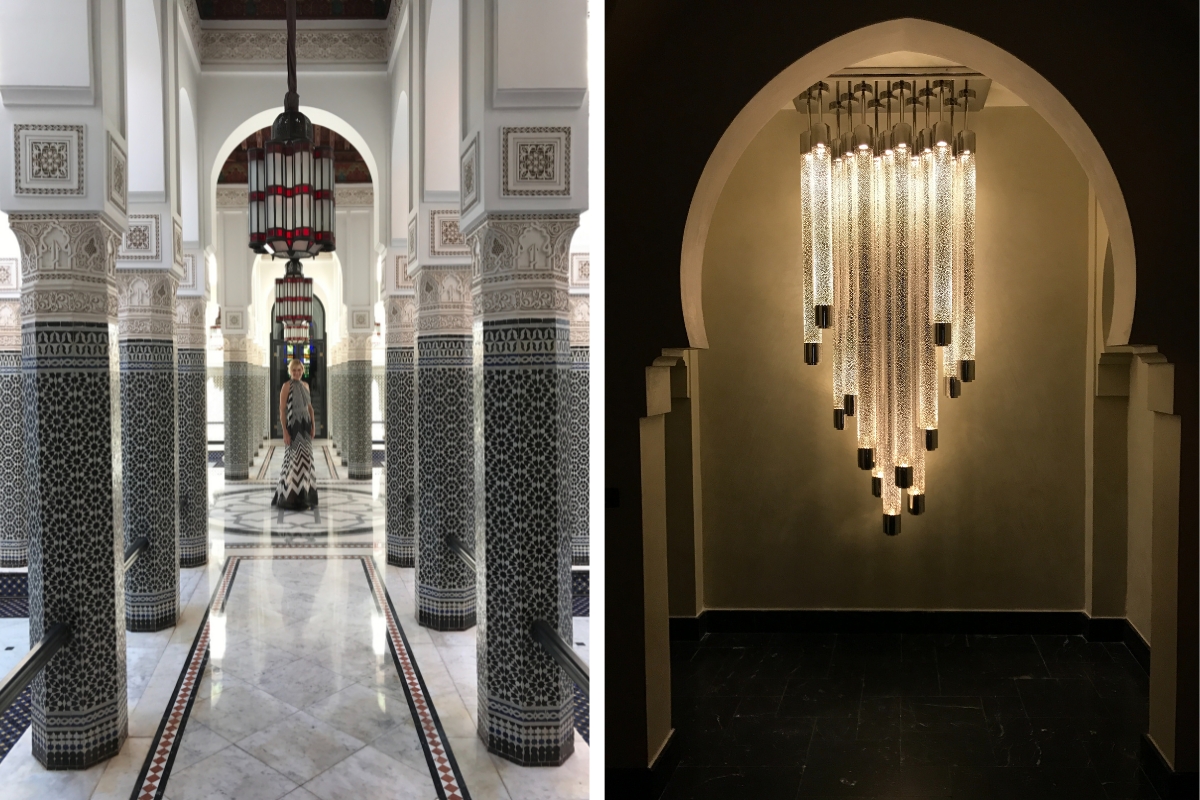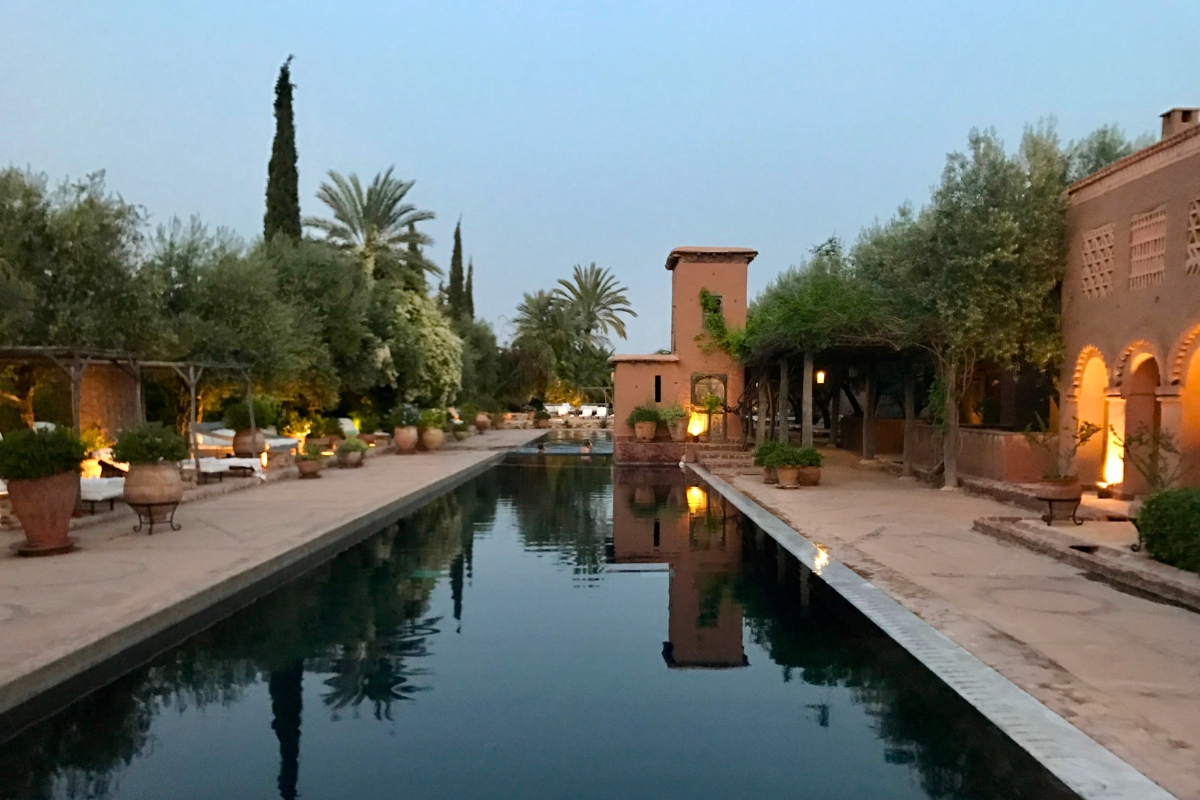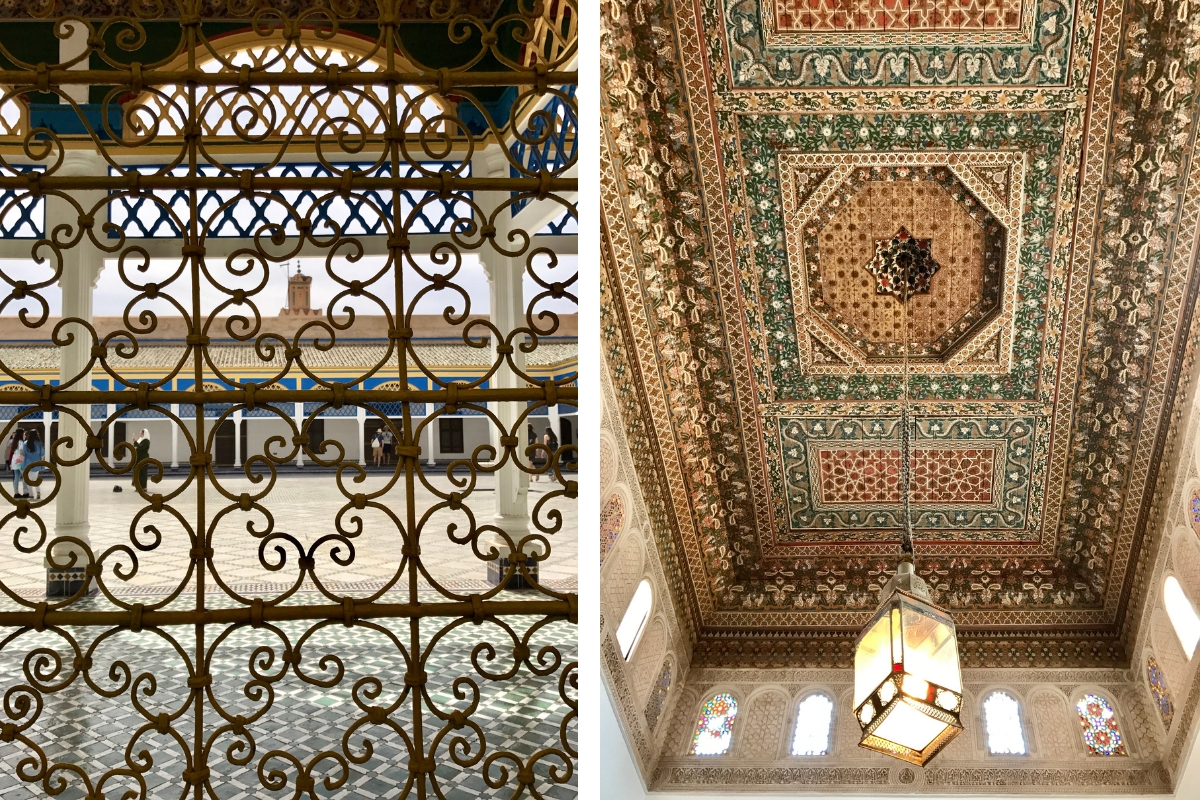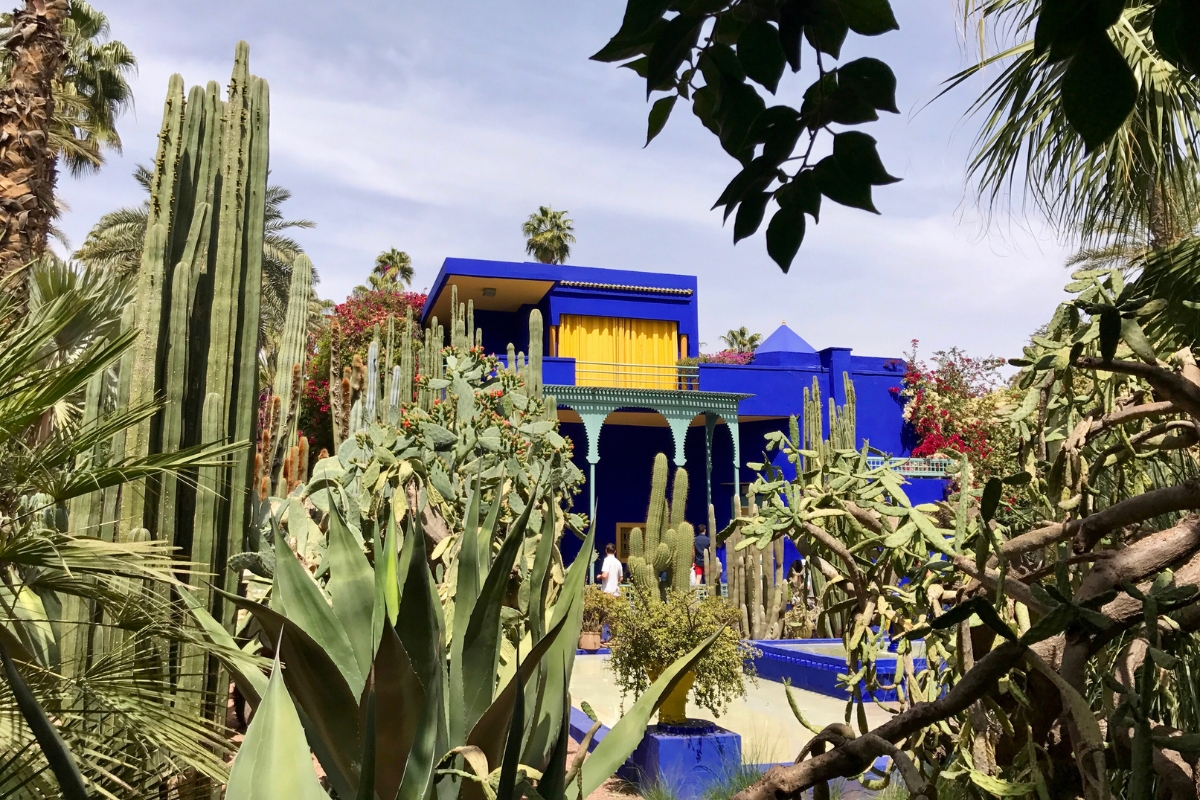A man from my riad (Moroccan-style hotel) drove me from the airport past newer buildings into the old quarter (medina) via an Arabic arcade surrounding the king’s palace. The “ochre city” immediately showed off its hallmark buildings of beaten clay. Horse-drawn carts drag-raced with slow-going cars on narrow roads, bins of spices poured out onto sidewalks and carpets hung for sale outside shops. It was like driving backwards in time.
The final journey to my riad required walking through a short maze of narrow, winding footpaths. A wooden door opened into a stunning courtyard full of natural light. I was greeted with warm Moroccan hospitality and mint tea. Immediately, I was at peace and enchanted. The phrase “as-salāmu ʿalaykum,” meaning “peace be unto you” in Arabic, captured the moment perfectly.
As a former French protectorate, I discovered that Marrakech is both Francophone and Franco-fantastic with its mélange of artistic and cultural influences. But it remains true to its Arabic roots, especially in the medina, as displayed in architecture, art, souks (Arab bazaars) and gastronomy.
WHERE TO STAY
Riads are a huge part of the cultural experience in Morocco. They are defined by a large, open courtyard with three or four stories of rooms encircling it, including a roof deck. They beautifully show off Arabic architecture and some are also French-inspired, resulting in a visual feast.

El Fenn is the ultimate in luxury with rooms featuring stained glass, colourful tiles and modern furnishings. It has an exquisite spa, rooftop terrace, cocktail bar, restaurant and boutique. (FYI, there are no keys to guest rooms based on the honour system.) Tarabel is a French-Moroccan riad with architecture and interiors representing both countries. There is a pool with its own bar and rooftop sundeck offering serenity and luxury beyond the imagination. Italy meets Morocco at the Riad & Spa Palais Blanc luxury mansion. As the name suggests, the property is entirely white with arabesque wall hangings and lanterns giving style to simple elegance. It has a pool, restaurant and spa. The Royal Mansour Marrakech drips in lavishness with four restaurants, several bars, a stunning spa, garden, pool, and art and culinary workshops. 
For traditional hotels with Moroccan décor and luxury, the 100+-year-old La Mamounia in the city centre and Beldi Country Club on the outskirts are outstanding choices. The Mamounia is a celebrity hot spot with an outstanding spa, a huge garden, five excellent restaurants, four bars and beautiful terraces. Beldi Country Club boasts a 15-hectare property with its own vegetable garden, chickens, glassware and ceramics – all of which are used in its restaurants and bars plus sold in an on-site souk. Beldi, meaning “authentic” in Arabic, also has a stunning flower garden and spa built like a tiny Moroccan village.

Traditional palace hotels combine French and Moroccan designs with luxurious spas, restaurants and bars. Palais Rhoul is Greco-Roman style, epitomized in its stunning outdoor pool surrounded by columns amidst a five-hectare garden. The Selman Marrakech has a private horse stud farm that you can visit to meet international prize-winning horses. Palais Namaskar has 12 acres of seclusion with tranquil lakes and huge guest accommodations, including villas and palaces.
Almost all have a private pool or an outdoor jacuzzi, and the palaces up to four bedrooms. Palais Ronsard, a Relais & Chateaux property, features bed canopies and a 20,000-square-metre garden with olive and palm trees, roses, rocky waterfalls and pools enclosed by colonnaded galleries.
WHAT TO SEE
Hiring a local guide is highly recommended to navigate through the poorly marked old city streets, especially in the souks. They can also negotiate taxi fares – which must always be done in advance – and determine stops in the best geographic order, including hard-to-find foundouks where craftsmen hand-make souk items like leather bags and dyed textiles.
Take in sunset overlooking the bustling Jemaa al-Fnaa market from a rooftop like that of Café de France or Le Salama to take in the action from afar and spectacular photos. Smoke swirls from grilling meat on sticks in numerous food stands, mimicking the dance of charmed snakes nearby. Completing the experience are street musicians, fortune tellers and vendors of all things Arabic that are delicious and illuminated. This massive market square is as alive as humanity can be. (Just beware assertive food vendors and if you’re lady-like, unsolicited grabs in crowds.) In the background is the striking tower of Kutubiyya Mosque.

Four heritage sites in the Medina showcase traditional Moroccan architecture, some with thousands of colourful tiles. The Dar Si Said Museum is a must-see with exquisite tiles on all surfaces, archways, columns, arabesques and lanterns. Another fine display of tiles is in the Bahia Palace, including on the floor of a massive courtyard, inside domes and lining intricate archways.
Mederssa Ben Youssef, a former Islamic college, offers an amazing courtyard, reflecting pool and second floor from which to photograph. Badi Palace is worth a visit for its fort-like structure, massive reflecting pool, courtyard and maze-like walkways. Get amazing photographs in the low-lit subterranean passage ways of the palace’s Méchouar-Kasbah.

For greenspace, check out Le Jardin Secret in the heart of the Medina, which displays exotic plants and trees amidst Arabic archways, engraved marble, paintings and fountains. A totally different look is at Jardin Majorelle, where the late Yves Saint Laurent built his vacation home and sprawling tropical garden. Except for bright cobalt blue and yellow paint on the house, it is a departure from Arabic influence, showing its French face instead. Go early or late to minimize crowds and catch softer sunlight. Next to the garden is the Musée (Museum) Yves Saint Laurent Marrakech in commemoration of the late fashion designer, who sketched many designs in Marrakesh, which he considered his second home after France.

WHAT TO TASTE
The hallmark of Moroccan cuisine is spice and it comes in all flavours, colours and forms. Must-try dishes are tanjia, slowly roasted lamb or other protein with vegetables in a bulbous clay pot; tajine, a Berber stew cooked in a conical clay dish; and couscous, tiny pearls of semolina served with meat and vegetables. In general, you can’t go wrong with dishes made from local ingredients, such as dates, saffron, preserved lemons, olives, sesame seeds, almonds, argan oil, and orange flower and rose waters.
Fabulous dining options have it all in food, atmosphere and entertainment. Le Comptoir Darna features classic local dishes, Moroccan wines, DJs and ladies dancing with candelabras on their heads in a magical atmosphere. Candlelit Bôzin is the epitome of romantic with Asian fusion cuisine, live music and dancing. Dar Moha has gastronomic “new Moroccan” cuisine with outdoor seating surrounding a colourful tiled pool. Le Palace Marrakesh offers French-inspired cuisine in an opulent, low-lit space as well as a basement boudoir decorated with photos of Yves Saint Laurent, where late-night dancing occurs on the furniture.
The Selman Marrakech offers a Sunday brunch with its Arabian horses in lush gardens. You can enjoy a buffet of local specialties while watching a horse parade. For a yummy Moroccan lunch with a view, wander near the spice market to Nomad, which has two rooftops. El Jardin is an elegant sister restaurant that features a stunning courtyard garden and double terrace.
WHAT TO DRINK
This officially dry country features divine non-alcoholic drinks, such as fresh-squeezed juices, rosewater infusions and almond milk with dates, but it also has jumped onto the non-Muslim world’s gourmet cocktail bandwagon – albeit appealing to wealthy locals and tourists. Enjoy both types of offerings.
Take a break from shopping in the souks at Café des Épices above the spice souk for an avocado juice-based drink, such as one with blended dates and almonds. Or sip a cocktail amidst panoramic views from MK Rooftop in the Maison MK riad (which also offers Moroccan cooking classes) or in the Royal Mansour hotel. The latter has several elegant bars, including a library bar and the Fireplace Lounge, which are each described as a voyage.
For gourmet cocktails or Moroccan wine, head to Le Baromètre or Le 68 Bar à Vin, respectively, in Marrakesh’s “new city” of Gueliz. Le Baromètre, denoted on a small street by a big letter “B”, gives gourmet cocktail bars in London and New York a run for their money. Opened by two hipster brothers, cocktail-making and -sipping are at their finest here with offerings incorporating exotic ingredients like rosewater, saffron and date syrup. Cocktail buffs can even take a mixology workshop. Lovers can enjoy Eye-Contact for shared sips via a U-shaped vessel with earphones to silently gaze at each other.
WHERE TO SHOP
Pack a large duffle bag in your suitcase to bring home Moroccan treasures as you will find many. Just be prepared to negotiate assertively in the Medina souks, starting at half the asking price. Even better? Ask your local guide to negotiate for you in Arabic. Take home Moroccan lanterns, carpets, tea sets, scarves, leather goods and more.
Popham Design, founded in 2007 by an American couple, offers modern Moroccan-inspired tiles. They are custom-designed and handmade at a Marrakech factory and shipped all over the world. There are over 200 designs with a range of vibrant colors. 
Date perfume and olive oil made from trees on the property are unique finds at La Mamounia. Hand-blown glassware from clear to vibrant colours is a great take-away from the Beldi Country Club. You can even see its glass-making factory in operation, the last of its kind in Morocco. Beldi also has a pottery studio, where you can learn the craft or buy products from professionals.
WHERE TO RELAX
Go to a hammam, a Muslim steam bath involving rigorous skin exfoliation, during your stay to soak up Moroccan culture. You’ll plunge into immediate relaxation and have the softest skin ever!

La Mamounia features a majestic 2,500-foot spa. Its entrance greets you with huge Arabic lanterns and crystal stalactites. Get sensory overload as you follow the visual wonders to a spectacular pool made of Moroccan tiles surrounded by Arabic archways.
Marajah Spa features Moroccan ancestral rituals in a luxurious wellness space on two floors with several hammam and massage cabins, plus a large relaxation room. The Royal Mansour spa looks like it’s made of lace with stunning, intricate, white marble canopies.
“We have made you nations in order for you to meet,” paraphrases the Holy Quran of international traveling. Meet the many splendours of Marrakech …
Image credits from top: Jemaas al-Fnaa snake charmer - ©VisitMarrakech&Region; Mamounia Hotel - Jennifer Chase / Angela Dansby; Beldi Country Club - Angela Dansby; Jemaa al Fnaa ©VisitMarrakech&Region; Souk and textiles - Angela Dansby; Bahia Palace - Angela Dansby; Madrasa Ben Youssef - ©VisitMarrakech&Region; Jardin Majorelle - Angela Dansby; Terra cotta tajines, grilled fish, date cake at Nomad restaurant and coctails at Le Barometre and El Jardin - Angela Dansby; Souk - Angela Dansby; Popham Design tiles - Angela Dansby; Mamounia Hotel pool and spa - Jennifer Chase.
Read Next
Copenhagen’s Alchemist Mixes Gastronomy with Social Impact
Belgium’s Rare Flower: Botanic Santuary Antwerp
The Surprising History of Superyacht Submarines









